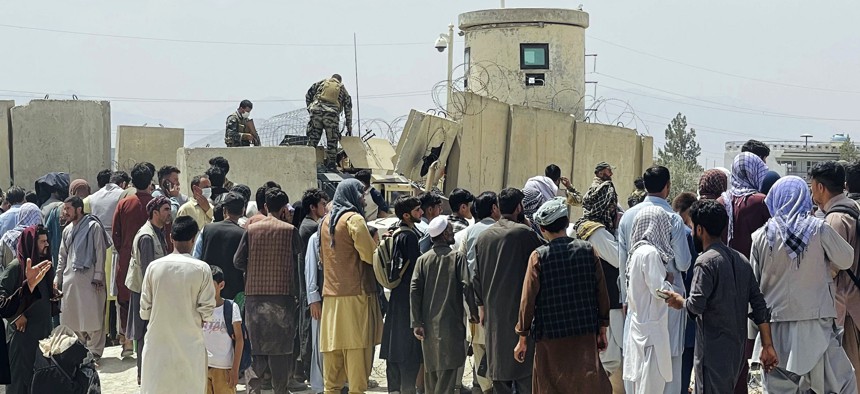
Afghan security guards stand on a wall as hundreds of people gather outside the international airport in Kabul, Afghanistan, Tuesday, Aug. 17, 2021. Associated Press
U.S. Ramps Up Emergency Kabul Airlift to Get 5,000 to 9,000 Out Per Day
American commanders are in direct talks with Taliban, who now control all outside access to the airport
The U.S. is ramping up its airlift for Americans and Afghans fleeing the Taliban and will be able to evacuate 5,000 to 9,000 people per day, Pentagon press secretary John Kirby said Tuesday.
The rapid escalation of military airlift—ramping up to as many as one departing flight per hour within the next 24 hours—is occurring as the Taliban have taken control of all traffic outside of Hamid Karzai International Airport.
Defense Department officials are now in direct talks with Taliban leaders on that perimeter security and to avoid any escalation of conflict while the U.S. conducts evacuation operations, Kirby said.
“Our commanders at the airport are in communication with Taliban commanders on the ground outside the airport, there have been discussions …. and I would just let the results speak for themselves,” Kirby said.
On Tuesday, the Pentagon also acknowledged the extraordinary efforts of an Air Mobility Command C-17 Globemaster crew, Reach 871, who chose not to force out hundreds of Afghans who scrambled over a half-closed back ramp and instead got as many aboard as they could, then took off, rescuing a total of 640 evacuees. The photo of their evacuation was exclusively reported by Defense One.
“This was an aircrew trying to be as humane as they could,” Kirby said in a phone interview. “That photo speaks a thousand words as to the humanity of that aircrew.”
Overnight, an additional 1,000 U.S. troops landed at the airfield to bolster the roughly 3,000 already there, said Maj. Gen. Hank Taylor, director of current operations for the Joint Chiefs of Staff.
Overnight, about another 700 Afghans and 165 American citizens were flown out of the country, Taylor said.
National Security Advisor Jake Sullivan said there are “reasonable” questions to be asked about whether the administration should have begun evacuating American citizens, diplomats, and Afghans who helped U.S. troops during the war earlier. But he said Afghan officials “made a passionate case” against a mass exodus that might signal a loss of support for the Afghan government.
“Our signaling support for the government obviously did not save the government, but this was a considered judgement,” Sullivan said at a briefing. “When you conclude 20 years of military action in a civil war in another country with the impacts of 20 years of decisions that have piled up, you have to make a lot of hard calls -- none with clean outcomes.”
Asked if there was anything the White House could have done to avoid the chaos at the airport in Kabul, Sullivan said that the situation on the ground once the Taliban came into Kabul would be the same even if there were no U.S. troops on the ground, adding that the administration has been urging Americans to leave the country for weeks, yet many chose to stay until the last possible minute.
“When a civil war comes to an end with an opposing force marching on the capital, there are going to be scenes of chaos. There are going to be lots of people leaving the country. That is not something that can be fundamentally avoided,” he said. “The fact is that we made the judgments we made based on the information we had at the time.”
When asked why the government is not working on a plan to help Americans and other allies get to the airport safely, Sullivan said many people have made their way to the airport without problems despite Taliban control of the city. He also said the administration has been “working, engaging, coordinating” with the Taliban to ensure safe passage to the airport.
Jacqueline Feldscher contributed to this report.
NEXT STORY: Analysis: You Can’t Buy a Cause







